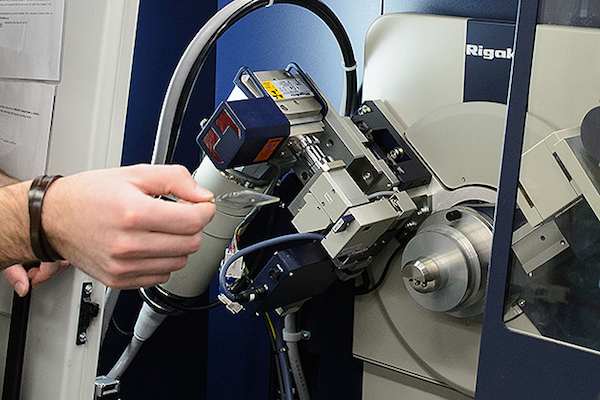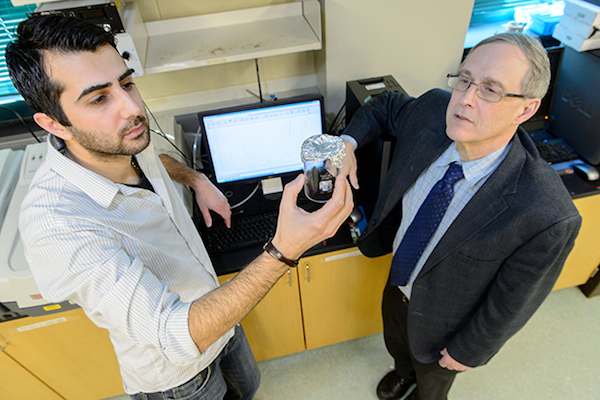
University of Connecticut scientists, including graduate student Altug Poyraz (left) and chemistry professor Steven Suib (right), have developed a new method to synthesize monomodal mesoporous materials. Credit: Peter Morenus/UConn Photo.
With large surface areas and a wide range of applications in adsorptive, sensing, optical, magnetic, and energy products, you have to love mesoporous materials (porosity ranging 5–20 nm diameter).
New research from the University of Connecticut may inspire you to love them a little more, because researchers have further widened those applications with the ability to uniformly manufacture these handy and holey materials.
Published in Nature Communications, the study details a novel method for synthesizing mesoporous materials that provides manufacturing flexibility by controlling the synthesis reaction in inverse micelles.
The method is an improvement to the standard, long-used, water-based method developed by Mobil in the 1990s. Materials synthesized with the old method were past due for an overhaul, because, as explained in a University press release,“The size of the pores in the material is difficult to manipulate; the walls of the resulting mesoporous structures are amorphous; and the stability of the underlying system weakens when exposed to high heat, limiting its use. The process also only works best when using silicon or titanium, as opposed to other metals of the periodic table.”
The new method, developed in the lab of chemistry professor Steven Suib, swaps water for a recyclable surfactant and heats things up in the process. According to the press release, the team’s development produced “thermally-controlled, thermally-stable, uniform mesoporous materials with very strong crystalline walls.” The process modifications made mesoporous materials with uniformly-distributed pores (1.2–25 nm) from oxides of manganese, cobalt and iron. Nitric oxide chemistry and heat allowed the scientists to adjust the pore size, providing manufacturing flexibility and control.
It is usually a good sign when the new technology has a corresponding patent application—and this one has four.
The flexibility of the process is key. In the paper, the authors write that their development allows synthesis from various types of elements, including late transition metals (Mn, Co, Fe and Ni), early transition metals (Ti and Zr), lanthanides (Ce), metalloids (Si), and nonmetals (C).
So it’s no surprise that Suib’s team is on a roll. “We developed more than 60 families of materials,” he said in the press release. “For every single material we made, you can make dozens of others like it. You can dope them by adding small amounts of impurities. You can alter their properties. You can make sulfides in addition to oxides. There is a lot more research that needs to be done.”
Of course, being able to synthesize mesoporous materials with uniform and controllable pore sizes means that materials can be tailored for specific applications. As Suib puts it in the press release, “With this process, you can now make a receptacle for specific proteins or enzymes so that they can enter the pores and specifically bind and react. That’s the hope, to be able to make a pore that will allow such materials to fit, to be able to make a pore that a scientist needs.”
The paper is “A General Approach to Crystalline and Monomodal Pore Size Mesoporous Materials” (DOI: 10.1038/ncomms3952).
Feature image credit: Peter Morenus/UConn Photo.

